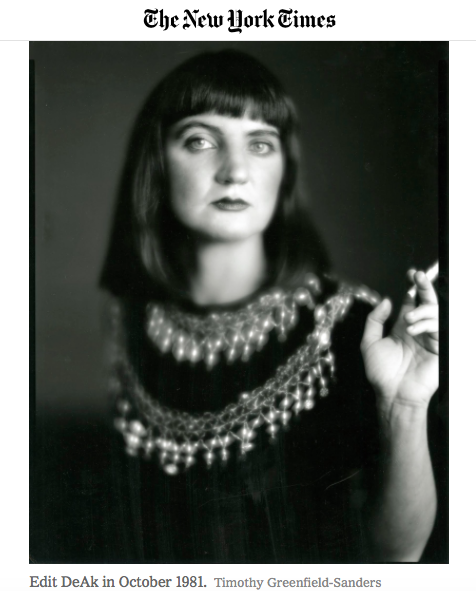My husband is the Rain Man of New York Times obituaries.
One morning I remarked that my art criticism teacher had once complained about my habit of starting assigned papers with a quote. (I would pore over Artforum magazines, extract an interesting statement and expound upon it.) She found it annoying that I would take something out of context in that way. Today, I would argue that anything commented upon is taken out of context. I would also point out that I was rather ahead of my time—this being nearly 25 years before WikiQuotes.
“Edit DeAk?” my husband replied. “I think she’s dead.”
“The idea becomes a machine that makes the art.”
Sol LeWitt
There are few things I remember about that art criticism class. One is the teacher’s name: Edit DeAk. She was Hungarian. She told us it was pronounced “edit,” as in the verb to edit. Another is her brilliant hennaed hair, haphazardly clipped back with barrettes in the form of tiny airplanes. The third is her annoyance with me. I can only imagine that it was supremely tiresome to take the train from New York City into the provinces of Connecticut to teach at a no-name art school full of bourgeois no-nothing students one day a week. What must she have thought of my nineteen-year-old sophomoric self, with my Kate Jackson haircut, corduroy blazers and Frye boots? Certainly her Hungarian parents did not spend their free time on the golf course and their money on fluff art school tuition.
There is one other student I remember from the class. Barnaby had big, delicate hands and a slight lisp. I recall him reading to us from William Burroughs—shocking stuff to me. The teacher took a shine to him. There was mention that he had been invited for weekends at her SoHo loft. I gathered that other students were, too.
My husband’s memory had not failed him. Sure enough, I found DeAk’s obituary in the Times. She had died in June of 2017. Pulmonary Distress. (It is said that the lungs can be consumed by grief.) She had smuggled herself out of Hungary in the trunk of a car when she was eighteen and made her way to Italy and then to New York, where she drew into the ever-evolving life of the lower Manhattan art scene. There, with a keen, insatiable intelligence, dramatic sense of style and sheer grit, she established herself as a cult-like fixture. She had co-founded her own magazine and publishing house and written for Artforum and Interview. When my sleepy art school had been stuck in conceptualism, she was on the quest for and living out the next hot experience in the Art World.
How differently would my life have unfolded if we had crossed one another’s frontiers—actually seen one another—if I had been invited to her Soho Salons and met Keith Haring and Jean-Michel Basquiat and witnessed them spray painting her living room walls? Would I have formed in a boldly disparate way or would my teeth and lungs have tarnished sepia from breathing in the smoke of unfiltered cigarettes and the heady air that enveloped the intense crop of young artists emerging on the streets of New York in the early 1980s?
Edit never confided to me that she actually knew Sol LeWitt.
She did; however, give me an A+ for the semester.

